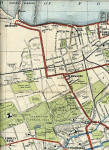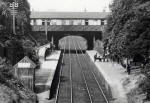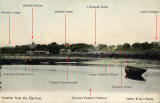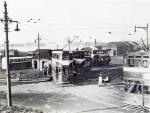Recollections Boswall - Granton - Trinity - Wardie in the 1940s |
||
|
1. |
Douglas
Beath |
Wardie Farm |
|
2. |
Douglas Beath |
Ferryfield Windlestrawlee |
|
3. |
Douglas Beath |
Boswall and Fraser Estates |
|
4. |
Douglas
Beath |
The Railway Crewe Toll to Granton |
|
5. |
Douglas Beath |
Granton Beach, Harbour and Square |
|
6. |
Douglas Beath |
Commercial Transport |
|
7. |
John
Stevenson |
Sentinel Lorries |
|
8. |
Douglas Beath |
Shops - Cash Handling Equipment |
|
9. |
Douglas Beath |
Granton Castle |
|
10. |
Douglas Beath |
Newhaven Fishwives |
|
11. |
Jack
Wilson |
Granton Beach and Wardie Steps |
|
12. |
Owen Hydes |
Searching for People |
|
13. |
John Stevenson |
The Embassy Cinema |
|
14. |
Malcolm J B Finlayson |
Trinity - Woodbine Cottagea |
|
15. |
Stuart McCann |
Trinity - York Road - Starbank Park |
|
16. |
Stuart McCann |
Trinity - Woodbine Cottagea |
|
Many of the recollections below have been provided by Douglas Beath who used to live in the Boswall/Granton district of Edinburgh in the 1940s and now lives in Tasmania, Australia. Douglas tells me that Tasmania also has a Granton, on the Derwent estuary near Hobart. |
||
|
Recollections 1 Douglas Beath Tasmania, Australia |
|
Douglas Beath wrote: Wardie Farm Rosebank Gardens "Wardie Farm was in the space now occupied by Rosebank Gardens, and was presumably much larger originally. I remember the farmhouse was a two-storey stone cottage on Rosebank Road. Across the cobbled farm entry alongside was the whitewashed slate-roofed dairy which in the 1940s was still bottling milk (presumably from churns from elsewhere) for local delivery by handcart. Their wheels and those of Morrison's dairy (the northmost shop from Granton Road Station) had been stripped of rubber tyres for the war effort: the early morning noise of empty glass bottles in steel crates on untyred wheels on hard pavements can be imagined. Local character Jock, who found comfort in something stronger than milk, had a room at the north end of the dairy. The disused farm buildings behind were a labyrinth of wood with red pantiles. A paddock was bounded by the back gardens of Afton Place and Granton Road. A stable housed two horses, "Glasgow" and another, used locally (by the Co-op perhaps). Wardie Farm could have been one of the district's oldest buildings. I hope it was photographed before demolition." |
|
[Douglas Beath, Tasmania, Australia - formerly Edinburgh - August 2004] |
|
Recollections 2 Douglas Beath Tasmania, Australia |
||||
|
Douglas Beath wrote: Ferryfield [Windlestrawlee] Old House "Windlestrawlee is a name of a house in North Edinburgh that appears on old maps in the area to the west of Granton Road, now occupied by Ferryfield housing The name, Windlestrawlee, has not been used in my time. The old house at Windlestrawlee lay central in Melville College's sports field on Ferry Road and Boswall Drive, an area built over around the 1960s. It was a modest symmetrical two storey building with central doors front & back. The walls may have been cement-rendered, and the roof was slate. The back area was flanked by single-storey outbuildings, whitewashed and slate-roofed. By the 1940s the house was empty and the outbuildings housed the groundsman's equipment. Mr Mann, wife, and our playmate Terry lived in a bungalow (I suspect of more recent construction) at the Ferry Road gate." Alan Fairweather replied:
Alan Fairweather added:
|
||||
Nursery "The nursery that lay to the west of Granton Road was also named Windlestrawlee." |
||||
|
[Douglas Beath, Tasmania, Australia - formerly Edinburgh - August 2004] |
|
Recollections 3 Douglas Beath Tasmania, Australia |
|
Douglas Beath wrote about the housing to the north of Ferry Road and to the west of Granton Road : 'The Boswall Estate "Bruce Peebles works (1910) must have seeded the Boswall Estate. The Corporation's Boswalls housing estate was notable architecturally. It avoided the monotony of identical houses all in line by using a small variety of designs and different set-backs. Take Boswall Avenue, south side : neighbouring houses differ pleasantly yet the street's west half is a mirror image of the east. And the uniform small-paned windows, rendered walls and slate roofs give the neighbourhood a coherent character (something almost unknown in Australia)." |
|
'The Frasers' "The steel houses that make up the Fraser estate were built by the Second Scottish National Housing Co (Housing Trust) based in Dunfermline. The estate is named after Provost Fraser of Dunfermline, who was one of the Housing Trust's Directors. |
|
[Douglas Beath, Tasmania, Australia - formerly Edinburgh - September 2004] |
|
Recollections 4 Douglas Beath Tasmania, Australia |
|
Douglas Beath wrote: The Railway Crewe Toll to Granton "West of Pilton Drive, the Edinburgh line rose to cross over Crewe Road, but the curve to Granton fell to cross under Crewe Road. The latter was abandoned and I remember its cutting gradually being filled. The parapet walls, uniform with others such as at Granton Road, were still part of Crewe Road North in 1955. The stone arch probably still carries the road above, even though hidden and forgotten ! Incidentally, the railway used the spelling CREW JUNCTION on its signal box at the Ferry Road double bridges. East Pilton Halt (note status) came later so, until Fraser Avenue and Boswall Avenue were built post-1918, Bruce Peebles' workers used a tarmac path along the top of the railway cutting to reach Granton Road trains and Leith Corp. trams. This path dipped to a subway under Boswall Drive, which should still be visible. It became an air raid shelter during the war." |
|
Pilton railway An Aural Recollection "On foggy nights, Firth of Forth foghorns added to the atmosphere, each with its distinctive sound. On dank nights, a laden freight train could be heard struggling to climb from Granton to Crew Junction. There would be a slow chuff . . . chuff . . . chuff . . . ch-ch-ch-ch-ch repeatedly as the loco lost traction and its wheels spun on the wet rails. I used to hear this from as far away as Boswall Drive. I felt for people near the railway in West Pilton, trying to sleep; and for the loco crew in their prolonged ordeal. But it was wartime and everyone had to make the best of it." |
|
[Douglas Beath, Tasmania, Australia - formerly Edinburgh - August 2004] |
|
Recollections 5 Douglas Beath Tasmania, Australia |
|
Douglas Beath wrote: Granton Beach, Harbour and Square in the 1940s " On summer days during the war Granton Beach would be thronged with families picnicking on the sand and children playing in the water and exploring rock pools; all quite unimaginable when I was confronted by the degraded scene in 1987" Granton Harbour with its coal loaders, ice works, fishing boats, and shipbuilding was a lure for curious lads. Granton Square was a busy tram terminus, and the shore road west to the gasworks was alive with railway movements and industry." |
|
[Douglas Beath, Tasmania, Australia - formerly Edinburgh - August 2004] |
|
Recollections 6 Douglas Beath Tasmania, Australia |
|
Thank you to Douglas Beath for the recollections of commercial transport in Edinburgh in the 1940s: |
|
Steam Lorries' " About 1947 was my last sight of a steam lorry, hissing and spitting its chain-driven way up Leith Street. Flour mills had been big users, and I believe were the last." |
|
Coal Merchants "Coal merchants' horse carts e.g. Bruce Lindsay Bros, Brotchie, had posts with tin placards stating their price per hundredweight (cwt) sack." |
|
Mechanical Horses " The railways' ubiquitous delivery vehicles included the articulated Scammell Mechanical Horse, highly manoeuverable in goods stations laid out for horse carts. The three-wheeled tractor had a singularly artless cab. From about 1950 the Scammell Scarab had a rounded cab of Bedford shape. " |
|
Mail Vans "Post Office mail vans circulated the streets several times a day emptying pillar boxes. Their black roofs (most shallow, some deep) sloped down over the cab. The red bodysides usually showed scrapes from the Calton Road G P O basement gate hinges. Later, steel-faced wooden rails along the sides may have disguised the problem." |
|
Newspaper Distribution " Newspaper distribution hot from the printery to newsagents was by motor-tricycle-based vans with shiny aluminium bodies. We would rush to take the bundle in from the kerbside." |
|
The 'Store Van' "The 'Store Van' was Leith Provident Cooperative Society's mobile shop which reached into housing estates. It was a large Albion-based forward-control clerestory van whose rear hinged up as a canopy over the counter. St Cuthbert's Cooperative Society had horse-drawn bread vans, some with streamlined cabs I kid you not! The reins were led in through a slot under the windscreen." |
|
Cleansing Department " The Corporation Cleansing Department's scaffy with barrow & broom has long disappeared; but I doubt if any had their portrait taken! The suburban dustcart comprised an agricultural tractor drawing a two-wheeled van trailer with roller shutters along the "window line". Boswall Drive was the route for huge Leyland Octopus eight-wheeled enclosed tippers carting bulk rubbish from some central depot to the reclamation at the foot of Gypsy Brae where Cramond Prom was to start. Much juvenile excitement accompanied the occasional tanker vehicle with water jet hose and big noisy suction hose hanging from a counterbalanced arm, to clear gutter sivers of sediment." |
|
Road Resurfacing " The road resurfacing gang used to set up camp in the Boswall Drive laybys at the railway bridge or at the bowling clubhouse. To our wide-eyed wonderment there was that king of beasts the steam roller with scarifying tines or tar spreader on the back, a steam traction engine, coal-fired tar boiler trailer, grit-spreading trailer, workmen's trailer, all the navvies' tools, and heaps of materials and fuel. Many a Meccano model was inspired by this spectacle! Tramtrack renewal camps had their special gear: air compressor and pneumatic chisels to break apart paving setts, generator (driven via a cable clipped to the overhead line) for electric welding & grinding, small industrial truck with rear-tipping hopper, and acetylene flares for floodlighting (not during the war)." |
|
[Douglas Beath, Tasmania, Australia - formerly Edinburgh - July 2003] |
|
Recollections 7 John Stevenson Trinity, Edinburgh |
|
Thank you to John Stevenson, Edinburgh for sending the following comments, after reading the message about steam lorries above: |
|
Two Sentinels Lorries "In early 1948 Henry Robb Ltd., Victoria Shipyards, bought two green painted Sentinel steam lorries from Todd's Flour Mills, Commercial Street, Leith. From memory they dated from around 1923/5 but I could be wrong! The two drivers were included in the sale!! |
|
Maintenance As a sixteen year old apprentice engineer in the yard maintenance department I was one of those who carried out a complete overhaul of these lorries during "Trades Week" 1948. Among my job's was renewing the studs on the top and bottom covers of the vertical boiler that stood in the cab and replace the drive chain and sprockets. The driver of one, "Davie" treated his vehicle like a private car - it was washed and cleaned out every day . He died a few years later of silicosis . This was put down to the fact he had stoked the boiler of this lorry for many years and had inhaled masses of coal dust. |
|
Vehicles in Use The vehicles were used to transport steel plates, frames, machinery and men to and from ships being repaired in the dock area. Legislation at that time allowed unlicensed vehicles to operate in the Dock Area as long as they were insured. The "steamers" were withdrawn from service in 1950/1 and I have no idea what happened to them." |
|
John Stevenson, Trinity, Edinburgh, 9 October 2005 |
|
Recollections 8 Douglas Beath Tasmania, Australia |
|
Thank you to Douglas Beath for the recollections of mechanical equipment used in department stores to transport cash from a customer to a central area then return a receipt together with the customer's change. This equipment was in use in the 1940s, long before the days of the self-service supermarket: |
|
Jenner's and Patrick Thomson's "Jenner's and Patrick Thomson's and other stores had the common Lamson Paragon in which cash & chitty went in a cartridge from counter to counting-house and back via vacuum tubes. All this exposed plumbing did nothing for the shop's decor. The noise of cartridges hurtling along and bursting out into receival baskets was part of department store atmosphere then. I see Beamish Museum has one." |
|
Leith Provident "More spectacular was the flying fox (Australian name from pioneer river-crossing method) comprising a taut wire from each counter to a central elevated counting-house. A cup receptacle was bayonet-hooked under a two-wheeled trolley running on the wire. It was drawn back against a spring by a pullcord, then catapulted at speed along the wire, slamming into the opposite catapult. I believe Leith Provident used these. There are disused remnants of flying foxes in shops in Sheffield, Tas. and Richmond, Vic." |
|
Leith Provident - Granton Road Branch "A third system was the most intrusive but earned forgiveness because it was a sight to behold. I used to go in not to buy anything but just to watch the contraption work. This was at Leith Provident's Granton Road branch opposite Grierson Avenue. Cash & doc. were put into a hollow four-inch wooden ball. The shop was festooned with a light wooden structure comprising a manual vertical lift at each counter that released the ball down a gently-sloping track with whatever straights and curves were necessary to reach the counting-house. Likewise for return journeys, though I can't remember how the ball was lowered to counter level; perhaps a spiral track - all part of the fun. If I 'd been around when it was dismantled, I would have bought it lock stock & balls. I wonder if it's now centrepiece in a shop museum somewhere. |
|
Douglas Beath, Tasmania, Australia - formerly Edinburgh - July 2003 |
|
Recollections 9. Douglas Beath Tasmania, Australia |
|
Thank you to Douglas Beath for the suggestion below: Granton Castle "Perhaps pictures and a para on one of Edinburgh's other castles, namely Granton Castle, would stir interest in Granton's pre-industrial history (pre-Waterfront, for sure!). This must have been that stout rough stone wall & gateway facing east over the bufferstop end of the LNER coal sidings west of West Pier, and other walls on the shore side of Caroline Park House." |
|
Douglas Beath, Tasmania, Australia - formerly Edinburgh - August 2004 |
|
Recollections 10. Douglas Beath Tasmania, Australia |
|
Thank you to Douglas Beath for the comment below: Newhaven Fishwives " Your Newhaven fishwives photos reminded me of seeing them on their rounds. Their creels would be loaded onto the tram driver's platform, fare "Luggage or Dog" one penny. During the war North Fort Street School housed a British Restaurant named 'The Laden Creel'. (There was another in a church hall in Rutland Street.)" |
|
Douglas Beath, Tasmania, Australia - formerly Edinburgh - August 2004 |
|
Recollections 11. Jack Wilson Somerset, England |
|
Thank you to Jack Wilson, who used to live at 142 Granton Road and now lives in Somerset, for his recollections. Jack wrote: Granton Beach and Wardie Steps "I learnt to swim on Granton beach and went to Granton school and then on to David Kilpatrick Collage or as we new it as( D K dozy kids ). I can remember Granton like yesterday. I was up there last year, 2006. My brother and I went to ring the bell. You should remember it. It was not a bell but the metal bars at the top of Wardie Steps and one was lose and you shake it to sound like bell . And bye the way I worked for T L Devlin at Granton and Newhaven in the fishmarket. I am 68 now and I had a great life there. I have photos of my Father with his lorry and the lorry fleet of Thomas Smith Transport that did all Devlin work . Jack Wilson, Somerset, England - January 6 + 7, 2007 |
|
Thank you to Jack for also sending recollections of Lochinvar and Devlin's yard. |
|
Recollections 12. Owen Hydes Mannings Heath, nr. Horsham, West Sussex, England |
|
Owen Hydes wrote: Searching for People "I would appreciate any information (good or bad!) on the Hydes family that lived at 4 Boswall Loan from 1927 to the 1950s. I remember visiting the house as a very young boy - it is where my grandparents John and Elizabeth Hydes lived with their three sons, the eldest of which was my father Thomas Eric. I am trying to trace my uncle John Harold Hydes (known as Harold) who attended Heriots school until 1933, and I believe became an apprentice at the Dunlop Rubber Company. Does anyone remember anybody from this family? Any information would be welcome. Many thanks." Owen Hydes, Mannings Heath, nr. Horsham, West Sussex, England: December 23, 2009 |
|
Reply to Owen? If you would like to send a reply to Owen, please email me, then I'll pass on your message to him. Thank you. Peter Stubbs: December 26, 2009 |
|
Recollections 13. John Stevenson Trinity, Edinburgh |
|
Here, John Stevenson remembers going to the Embassy Cinema in Boswall Parkway in the late-1940s. John tells me: |
|
The Embassy Cinema Late 1940s "I remember that In the late-1940s, The Embassy Cinema was only open on three days a week: - Wednesday: Matinée and Evenings) - Friday: Evenings - Saturday: Evenings. I used to go to the Wednesday Matinee performances with my brother. We were given four shillings (20p in today's money) for the evening. It cost us 1/6d each to get into the cinema and 6d each for a bag of chips on the way home." John D Stevenson Trinity Edinburgh: February 5, 2013 |
|
A Bag of Chips 6d I grew up in Yorkshire but I share John's memories of regularly calling into the 'fish & chip' shops, as a teenager, to take away a 6d bag of chips on my way home in the evenings. The chips were wrapped in newspaper that kept them hot. I usually asked for 'chips and scraps'. There was no additional charge for the scraps. The scraps were the bits of crispy batter that came off the fish when it was being cooked. They tasted good with the chips. Peter Stubbs: Edinburgh, February 7, 2013 |
|
Recollections 14. Malcolm J B Finlayson Arbroath, Angus, Scotland |
|
Malcolm J B Finlayson who wrote: |
|
Trinity Woodbine Cottage "My parents owned Woodbine Cottage, 30 York Road, Trinity, from 1939 for approximately ten years." Haunted "My mother died in 2006. Recently, my cousin advised me that my mother confided in her that Woodbine Cottage was haunted. This must have been very frightening for her as she stayed alone in the cottage from 1942 until 1946, as my father was serving in India during the war." Smuggling "It is rumoured that there is a secret passage between the shore and the cottage that was used by smugglers. (I hasten to add, that was many years before my mother was the occupant!) This may be connected to the ghostly noises heard by my mother. Question "Does anyone have any further knowledge of the history of Woodbine Cottage?" Malcolm J B Finlayson, Arbroath, Angus, Scotland: October 13, 2013 |
|
Reply to Malcolm? If you'd like to send a reply to Malcolm, please email me, than I'll pass on his email address to you. Thank you. Peter Stubbs, Edinburgh: October 22, 2013 |
|
Recollections 15. Stuart McCann Bairnsdale, Victoria, Australia |
|
|
Thank you to Stuart McCann for responding to the message in Recollections 14 above about Woodbine Cottage in York Road. Stuart, who once lied in Trinity Crescent at the foot of York Road, wrote: |
|
|
Trinity York Road "I knew York Road pretty well as we used to sledge down it in the winter. I lived in Trinity Crescent during the war. On the west side of York Road (the right-hand side as you go up the hill from the coast) there were no houses from the bottom of the road the breast of the hill. Allotments started about half way up the hill and the backyards of Trinity Crescent tenements went up as far as the allotments On the least side of the road, I remember two mansions. These which were used by watchers looking out over the Forth. Soldiers were posted in one or perhaps both, and they gave the houses a hard time. The grounds of the two houses ran side by side right down to the backyards of the houses facing the sea wall. I'm finding it hard to workout where Woodbine cottage fits in to the story.
Starbank Park "From the foot of York Road, houses ran along to the east, to the Starbank Pub and then Starbank Park. That's the same name as the first trawler I ever sailed on in 1943 at fourteen years old - a long time ago!" Stuart McCann, Bairnsdale, Victoria, Australia: December 2, 2013 |
|
Recollections 16. Stuart McCann Bairnsdale, Victoria, Australia |
|
I sent a short email to Stuart McCann after reading his comments. See Recollections 15 above. Stuart replied: |
|
Trinity Woodbine Cottage "Thank you for letting me know that Woodbine Cottage was, in fact, quite a long way up York Road. So, it hardly likely to have any passage from the sea front." Woodbine Cottage "Looking at Google maps I see a vast difference today to what the area was like in my day. All the allotments are gone and a block of units has been built there. Even the house on the right did not exist in my day, but they've done a nice job of the stonework to make it look as if it has always been there. There used to be no buildings on either side before the two big gateways at the top on the hill." Stuart McCann, Bairnsdale, Victoria, Australia: December 2, 2013 |
|
North Edinburgh Cramond - Granton - Royston - Trinity - Wardie |
|
|
Maps Granton: transport map 1932 Granton: small map 1870 Granton: large map 1870 |
Recollections Cramond: from 1940s Cramond Island: 1970s Granton: 1930s 1940s 1950s 1970s Granton, Trinity, Wardie: 1940s 1950s - 60s Shops Lower Granton Road all dates Muirhouse from 1930s Pilton: 1940 bomb Royston: from 1930s |
|
History Granton, Trinity, Wardie: from 1544 |
|



